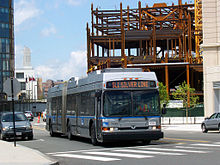
Back Hybridní trolejbus Czech Duo-Bus German バス (交通機関)#その他の特殊なバス Japanese Duobuss NB Duobus Polish Дуобус Russian Hybridný trolejbus Slovak Duobuss Swedish Дуобус Ukrainian

A dual-mode bus is a bus that can run independently on power from two different sources, typically electricity from overhead lines like a trolleybus or from batteries like a hybrid bus, alternated with conventional fossil fuel (generally diesel fuel). In contrast to other hybrid buses, dual-mode buses can run forever exclusively on their electric power source (wires). Several of the examples listed below involve the use of dual-mode buses to travel through a tunnel on electric overhead power.
Many modern trolleybuses are equipped with auxiliary propulsion systems, either using a small diesel engine or battery power, allowing movement away from the overhead wires, called "off-wire" movement, but such vehicles are generally not considered to be dual-mode buses if their off-wire capability is very limited. Examples include the fleet of about 300 trolleybuses in San Francisco[1] and the trolleybuses used on a 2005-opened system in Rome, Italy,[2] which are capable of running on battery power only for short distances or short periods of time before needing recharging. The Rome vehicles are powered from overhead trolley wires over most of the 11.5-km route and only use battery power on the 500-metre section closest to the city centre.[2] Dual mode trolleybuses in a number of Chinese cities can operate significant distances (8 to 10 km) off-wire on battery power.[3]
- ^ "About Trolley Buses". San Francisco MTA. Archived from the original on 2011-12-18. Retrieved 2009-12-15.
- ^ a b Webb, Mary (ed.) (2009). Jane's Urban Transport Systems 2009-2010, p. 195. Coulsdon (UK): Jane's Information Group. ISBN 978-0-7106-2903-6.
- ^ Luan, Xiaona 栾晓娜 (2014-06-26). 上海无轨电车"复兴":全换成新型辫子车 车辆增加两倍. 东方网 (in Chinese). Archived from the original on 2017-10-11. Retrieved 2017-10-11.